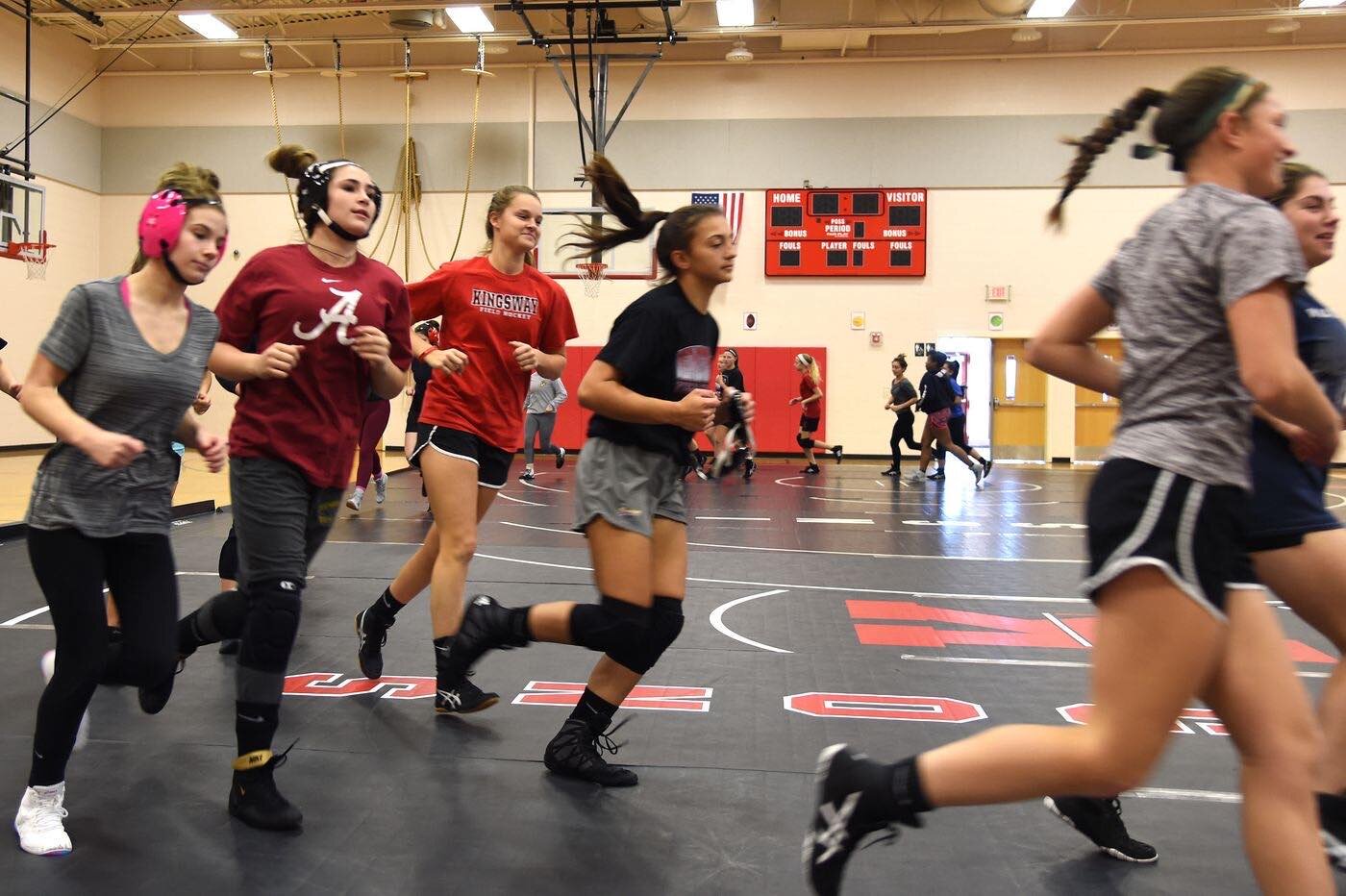Another Paradigm
Photo courtesy of Philadelphia Inquirer.
by guest columnist, Shannyn Gillespie
IG: @coachshannyntalks
Twitter: @coachshannyn
About a decade ago, A new paradigm, was written and discussed a way of high performance training suitable for developing & growing successful student-athletes. This article will preview ways & means to execute small (participation numbers) female wrestling competitions that help wrestling develop & grow. To start, the author learned this development strategy from the Canadians and at many youth or lower level competitions.
Canada
The population of Canada is about 37 million people. The population of the USA is about 327 million. So, how can a country roughly the size of California’s population compete globally in women’s wrestling? This question stems from the fact that Canada actually has more women’s wrestling Olympic Champions (2) than the USA (1). The answer to the former question likely has many answers that deal with developmental factors — one of which we will focus on here…
Back when the author was a women’s wrestling coach at the US Olympic Education Center, he noticed how many of the Canadian women’s wrestling tournaments were small, pool type, round-robin competitions. This fact could help many USA high school girl wrestling programs develop & grow too as you will soon read.... So how did the Canadian’s structure their women’s wrestling tournaments?
To rephrase, many of the Canadian women’s wrestling tournaments were round-robin competitions or line brackets (with pools) where each participant wrestled everyone per bracket.
Round-robins & line brackets
Round-robin brackets suggests a format with regard to pooling wrestlers except that there is typically only one pool per weight class. In a round-robin competition, wrestlers wrestle everyone in their pool. This means that a pool of 3, 4, or 5 wrestlers will elicit 2, 3, or 4 wrestling matches respectively per wrestler & pool size.
Line brackets (used at “Fargo” or “Jr. Nationals”) indicate where there are 2 pools with similar sizes of participants on each side. In a line bracket, there could be 2 pools of 4 wrestlers where, generally, each wrestler gets a minimum of 3 matches/bouts and sometimes up to 5 bouts. This way of formatting a competition is much more effective because it maximizes the amount of wrestling bouts each wrestler gets — especially for a lower number of participants per competition.
Round-robins (and line brackets) create more development opportunities via competition. Here is another example: in a round-robin of 3 wrestlers, all three wrestlers get 2 matches — in a traditional 4-person or 8-person bracket, only 2 wrestlers get 2 matches. These “extra” matches, or bouts, add up over the course of a season and help wrestlers grow, develop, & learn by experience during competitions.
Youth competitions
Many youth wrestling clubs do not have many or any dual meets which will be discussed soon. Some reasons why 8th grade & under wrestling clubs do not have duals are: team is not big enough to fill every weight class, difference in skill & age for competitors, several wrestlers in the same weight class, & tradition. The last point, tradition, means that many youth clubs participate in round-robin like competitions every Sunday (and have done so for decades in many cases). Generally, round-robin competitions allow pooling of wrestlers with similar age & experience plus they allow everyone to get at least 2 matches in a pool of 3 wrestlers. Can this concept also work for high school girl wrestlers?
Festivals or fests
Yes is the answer to the last question and Homewood-Flossmoor H.S. (IL) has proved it the last 2 years with their HF Girls Fest series. The goal of these fests is to get high school girls 2-3 wrestling matches per competition. These fests do not award medals nor placements so they are not considered tournaments. This is key because in IL, high school wrestlers are allowed only 4 tournaments per year prior to the state series (HF offers 3 girls fests per season plus 1 girls tournament). Other IL high schools could use this same developmental strategy to help develop & grow their girls teams and stay in compliance with the IL High School Association. Also, IL coaches can start to plan these Girls Fests similar to the way they plan boys duals and below you will see an example of how many high school girls duals could be organized.
Duals & dual meets
Traditional high school boys dual meets have about 14 weight classes from 106 lbs to 285 lbs and have 2 teams competing against each other. In an era where wrestling participation numbers have been declining, what could be a solution to all of those weight classes that are not filled or being forfeited? Another paradigm could be the answer... Or, how about changing the format of the traditional dual to include wrestlers of similar weight classes competing against each other and/or with more than 2 teams? This could mean 2 teams have 7 wrestlers who weigh from 113-126 lbs — and they all wrestle each other. Or, 3 teams have 10-15 total wrestlers and they all compete against each other (similar to the last sentence). How does this look?
Here’s an example of what that type of dual could look like (minus forfeiting any weight classes):
Homewood-Flossmoor vs. Joliet Central, Romeoville Dual
113 lbs Lexi Klaff (JC) over Diana Martin (HF) 6-2
113 lbs Diana Martin (HF) over Itsel Vivian (JC) Pin
126 lbs Savannah Holly (HF) over Ana Franco (JC) 7-2
126 lbs Stephany Serena (JC) over Celeste Carrillo (HF) Pin
126 lbs Madison Schilsoma (JC) over Celeste Carrillo (HF) 15-0
126 lbs Nicole Aguire (JC)over Charlotte Holly (HF)
126 lbs Dioselina Tenorio (JC) over Charlotte Holly (HF) Pin
138 lbs Maddie Skowronski (HF) over Natalia Gonzalez (JC) Pin
138 lbs Maddie Skowronski (HF) over Pilar Mendoza (JC) Pin
145 lbs Alima Toheeb-Lawal (HF) over Debora Hernandez (JC) Pin
160 lbs Attalia Watson (HF) over Steph Castro (JC) Pin
170 lbs Nydia Martinez (JC) over Stacy Noris (HF) Pin
220 lbs Fernanda Vazquez (HF) over CeCe Del Angel (JC) Pin
220 lbs Fernanda Vazquez (HF) over Samantha Ruanu (Romeo) Pin
285 lbs Jada Phillips (HF) over Samantha Ruano (Romeo) Pin
In the above dual, 15 matches were contested in 8 different weight classes. This structure resembles a typical fight card of professional boxing or mma. In other words, wrestlers are placed together by weight class and there is no formal prescribed number of weight classes nor bouts to be contested. The number of weight classes & bouts is organized by the coaches and this may be a way more high school girls competitions can be run or organized until all USA high school state organizations sanction wrestling for girls.
Promoting the sport
Stand alone girls high school events are a way to promote (grow) wrestling and high school girls wrestling. In addition to high school girls wrestling development, these things also happen at girls wrestling events: concessions can be sold, entry fees can be charged, & t-shirts can be purchased. What does this have to do with promotion (growth)? People talk about events that they go to and many times, they remember that the event was run & organized well. Also, if the girls competition is promoted on social media, the opportunity to reach many more people & young people is multiplied. These 2 types of word of mouth promotion are priceless! For a more detailed look at promoting & growing girls wrestling, please view Where It All Begins for Many Females: High School Wrestling Coaches.
Articles like this one and many of the hyper-links inside this paper are given as examples to produce more content (articles, videos, pictures) by wrestling coaches & parents of wrestlers — plus to help promote the sport and more specifically develop & grow high school girls wrestling.
It is part of our job to preserve, grow, & promote the sport!

